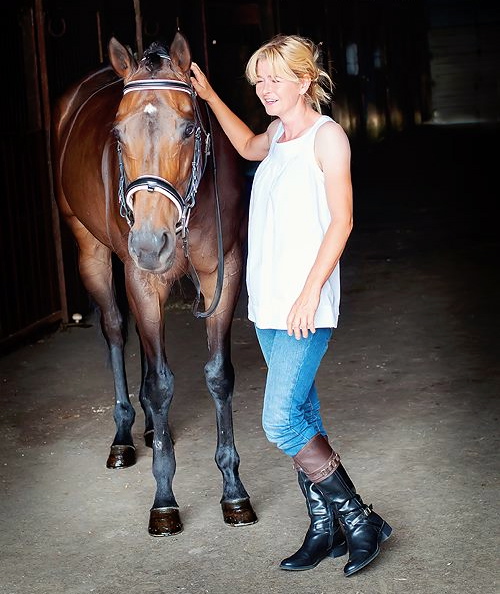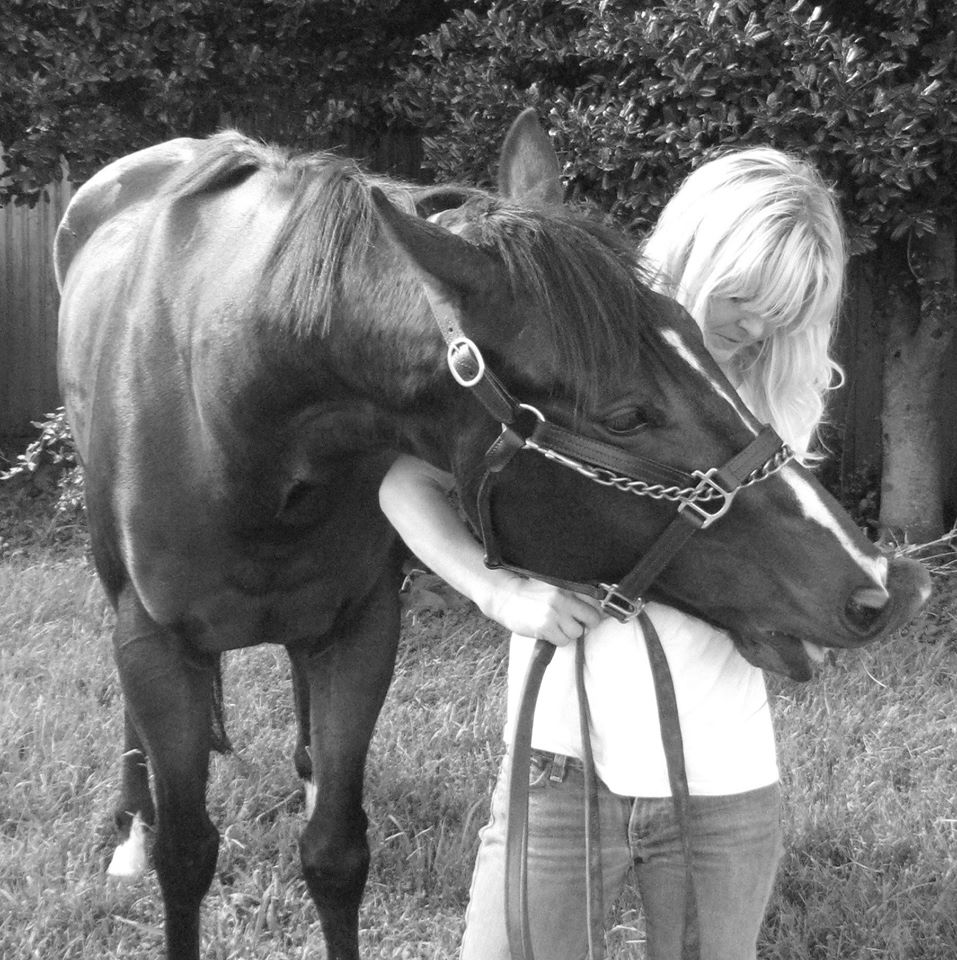The Chestnuts sparkle brightly in the late-morning sun, and Grays pop from the page, their dappled coats glistening on a cloudy day.
Nearly every scene captured of the fair-haired lady and the hundreds of Thoroughbreds her photos have helped sell, appear to be from Ralph Lauren or Horse and Hound. All carefully crafted with a few tricks of the trade.
In this week’s Clubhouse Q&A, Lisa Molloy, a deeply seasoned Thoroughbred trainer who has worked for several re-homing organizations, and currently heads up ReRun, Inc. in Virginia, and also works with Akindale Thoroughbred Rescue, tells us her secrets for bringing out the beauty of T-Breds, making them into “dream horses” for prospective buyers.
Q: Many have asked you what your secret is for turning out Thoroughbreds like Ralph Lauren models. Care to share?
To start with, I have a clean horse, and clean tack.
There are so many tiny, little things that can be done to enhance the overall picture. For example, lighting is critical for different horses. For grays, it’s better to photograph them on overcast days, because they look better.

Molloy brings the shine out in her sale horses before having their glamor shots done. Photo by Cecillia B Photography
But, if you’re photographing a chestnut or bay, you want late-morning sun, before 10 or 11. After that, the sun is too high in the sky, and you get long shadows falling off their legs, which isn’t attractive.
In the composition of a good photo, you also have to take into account what’s behind you. If you take a photo of fence behind you, you may get the appearance the horse has been impaled on the fence post.
We want the horses looking as level as possible. Some people like to show them food so they’ll reach forward, but I don’t do that, because I don’t want them to look too far forward.
To get them to pose properly, I can strike a cigarette lighter to get them to look at it, or a mirror, and tilt it and anything that will catch attention.
The big Quarter Horse photographers have tape recordings of mares screaming. When you see the perfectly posed horses, standing forward, they’ve all listening to a recording!
The whole goal is you want them to look interested without them looking mortified.
Q: There are also several beauty secrets you employ to get a horse looking his or her best.
It starts with the bath. I wash all of mine in Head & Shoulders, so they don’t have any skin problems whatsoever. And, I use baby shampoo for their faces, so if it gets in their eyes, it doesn’t sting.
Then, I use a purple shampoo to remove any orange or yellow tint from gray or white hair, and I’ll washing their white stockings or socks with that until they’re bright white.
If I’ve got a gray with a nasty tail, I might leave the purple shampoo on for 10 minutes, wash it off, and do it again. You can do the same thing with your own hair to take discoloration out!
If I’ve got a sun-bleached horse, I’ll dye their tales back to black. I use an inexpensive, women’s hair dye.
I also use a Show Touchup spray that comes in every horse color there is to do touchups.
I use hoof-black and to paint the hooves black, and spray-paint to enhance the black on their legs as well. It just makes ping more and look sharper.
Another secret is women’s hair spray! I spray over the top of the hooves to make them shiny.
I also pay a lot of attention to the tails. If I have a bay horse with some bleached bits, I spray the entire tail black. If I’ve one with a scraggly tail, I blunt trim the end of the tail. Even cutting it a half an inch— just like with a women’s hair— can make it look thicker.
I help them look their best by enhancing their natural beauty, but one thing you cannot do, if you’re marketing a horse for sale or adoption, is to cover up any scars.
Another thing that keeps them looking their best, is keeping blankets on. I use blankets with nylon liners. The blankets keep the hair down, and the nylon keeps their coats fairly shiny.
Q: Where did you learn these techniques?
I worked for 10 years for Bob Perry Quarter Horses in Texas, where the most famous Quarter Horse stallion stood at stud.
My first exposure came one day, when one of the farm managers asked me to go get some horses cleaned up for a photo shoot. I groomed the horse like I always would, and was kind of proud when I brought him over to her. She looked at the horse and said, “Oh my God! I can’t take photos of him looking like this!”
And she wheeled out this cart full of stuff, and I started learning after that.
Q: How did you incorporate these glamour shots into your efforts to help sell ex-racehorse Thoroughbreds?
When I got involved with Thoroughbreds, it seemed that if you looked at charity horse listings, what you saw was the same bay horse. Nothing distinguished them. It was bay horse after bay horse after bay horse.
Although I can look at a horse and use my imagination to see how he could look, I don’t want to leave that up to the buyer’s imagination. There are so many ex-racehorses out there, and its buyer’s market, so I believe in representing each one as best as you can.
Q: How effective have the photos been in advertising OTTBs?
I think it’s very effective because the photographs snag peoples’ attention, and anything that gets people interested is a good thing.
A lot of people have this misperception of retired racehorses. Some think they’re all “rescue” horses, which they’re not, and other expect some raggedy, mistreated thing. They’re shocked when the come see our horses! — This interview was originally published Nov. 7, 2012.
To donate to ReRun, Inc., please click this hyperlink to nonprofit charity’s donation page. ♦
![]() And if you have a moment, please visit the blog’s new store, Off-Track Products. Proceeds will help sustain this blog in the future, and go to charity.
And if you have a moment, please visit the blog’s new store, Off-Track Products. Proceeds will help sustain this blog in the future, and go to charity.





I’ve always thought the photographs of the horses listed on Lisa’s site are so beautiful – now I know how much thought and work she puts into them!! Great work!!
What perfect timing, still helpful 12 (?!) years later. I’m forwarding these tips to the participants in the CANTER New England’s Thoroughbred Breed demo at Equine Affaire in Massachusetts next month. Many of them are experienced competitors so I expect they have a few more turn out tricks up their sleeves. I’m looking forward to seeing the contrast between dressage turn out and show ring hunter turn out. We hope to see you at the Thoroughbred breed demo it will be at 3:00 p.m. on Sunday, November 16th in the Coliseum.